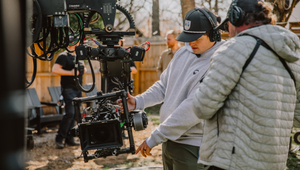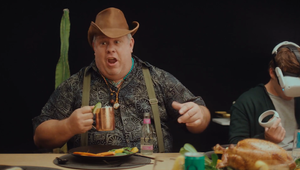
Switch: How Gear Seven’s Passion Project Spoke to the Soul of Skating

In the world of filmmaking and creativity, passion has a lot to answer for. Invariably, it's the force which compels generation after generation of talent to sign up for film school, to spend late nights editing projects together, and to embark on an often risky career in the industry.
It’s precisely that kind of passion to which Switch, a Gear Seven Original, is a kind of ode. Not just because it started life as an internal project willed into existence by the studio’s team, but also because of its subject. Over the course of a brisk three and a half minutes, we see for ourselves the value of skating, blading, and biking to communities in Nashville, Tennessee.
The resulting vignette stands, in the words of its creators, as “a singular voice of appreciation for skating in the lives of those who hold it closest”.
To go behind the scenes of the film, and find out how it travelled from idea to reality, LBB spoke to director JT McCreery and Gear Seven’s founder Kirk Slawek.
LBB> JT, how closely does the finished film align with the vision you had at the outset of the project?
JT> Better than I imagined it would. As a filmmaker you often have to make a lot of concessions over the course of an entire project. A friend of mine, Colin Noel, always says you tend to end up making three films: The one you plan in pre-production, the one you shoot, and the one you end up with. But on this occasion it does closely align with our initial intentions, which is great.
I think that’s partly because we’d already sketched out the beats of the edit and picked a track, so we already knew what the big moments needed to be. We planned out several moves that we knew were going to be critical at certain points. But most of all I think it turned out the way it did because of the vulnerability and authenticity of the interviewees. Our subjects became the heroes you always hope they will be for a piece like this. That made it super easy for us, and helped it turn out better than I imagined.
LBB> So what steps did you take to ensure everything did come off authentically?
JT> We tried to keep the questions broad, and the tone informal. All credit needs to go to them for taking the questions and answering them in such a beautiful and sincere way. They gave us a great insight into what skating means for them, and where their passion comes from.
LBB> Kirk, can you tell us how this idea first came to materialise within Gear Seven?
Kirk> The idea can be traced back to JT, our creative director, who sparked the idea alongside a collaboration with Patrick Wilson. Shooting something related to sports with a narrative wrapped around it has been a long-term goal for us, so from our perspective it made total sense to give the green light. On top of all that, it was an opportunity to hone in on something everyone would be proud of.

LBB> And why is it important for you guys to pursue this kind of original content in-house?
Kirk> This is a new thing for us - I believe I’m right in saying that this is the first official piece that we’ve produced internally and with our own creative team. It’s something we’re trying to do more of, simply because producing stuff we enjoy making is a great way to fuel fresh ideas, and stimulate creativity across all our teams.
LBB> As well as this film being a Gear Seven original, Shift Dynamics also brought the production to life. How helpful was it to tap into their infrastructure?
Kirk> Yeah, it’s super helpful to be able to rely on that equipment in-house. We ended up bringing out the AGITO, and SRH360 phantom for the high-speed camera in addition to the standard production package. We landed on using the AGITO so that we could get down into the bowl more easily, and move quickly throughout the day in a general sense. We didn’t use steadicam - and it was quite a hot day - so that gave us an extra challenge to grapple with!

LBB> JT, I've read that you see filmmaking as a “vast empathy mechanism”. Do you think that this kind of documentary-style is a good way to spark empathy?
JT> Yeah, that’s probably my favourite part about doing doc work. It’s real people, their backgrounds, their motivations, and their wounds. Especially when it’s a subject like this and you have people who are prepared to let you in. Skate culture can get a bad reputation but when you hear about the passion and what these people have found within the sport it’s magical. Anyone should be so lucky to have such passion in their lives. So I certainly think that can drive empathy. It did for me.
LBB> And speaking of which, did you take inspiration from any other documentaries - either on this specific project or across your career more broadly?
JT> For sure. I’ve seen some amazing doc work done - the one that stands out to me is one which I watched really early in my career which was Senna. That was a film about the extraordinary life of Ayrton Senna, a Formula One driver who tragically passed away in a car wreck. The amazing thing about that film was that it felt so intimate because there was no interview footage, it was all B-roll.
I saw this project in a similar vein where you never saw people talking and the emotion came from watching them all skating around. It’s intriguing to see how an audience can connect with a subject through B-roll, and without seeing them speak on camera.
LBB> What was the biggest challenge you encountered during production, and how did you overcome it?
JT> At midday, we’d got about half the footage we needed but due to unforeseen circumstances some of the talent who were scheduled to arrive were unable to make it. This meant that we didn’t have what we required to get the film looking as we envisioned it in pre-production. But before we had the chance to hastily re-draw our plans, Cody Fisher (our producer) sprung into action and literally ran downtown to find more people. Those last-minute heroics totally rescued the vision we had for the piece. So big ups to Cody for not taking no for an answer, and making things happen.
Kirk> I’d say the biggest challenge was technical. Everything worked well, but it was simply a case of working out how to translate the creative into technical action. JT wanted everything to feel legitimate, so there were a number of long takes. I was there for the filming of the intro scene, and it was cool to see everything come together quite seamlessly for what was a complex shot. Fortunately there was never a shortage of ideas on-set, which is just what’s needed when it comes to problem-solving.

LBB> Can we expect to see more Gear Seven originals in the near future?
Kirk> I certainly hope so. There have been a lot of ideas and concepts, and we’ve been exploring internally as to what our next project is going to be. But I definitely think there should be some more heading out the door in the near future.
LBB> And is there anything you’d do differently if you could do it again?
Kirk> In a very practical sense I would have chosen to do the shoot on a day with comfortable weather. As it happened the day we picked happened to coincide with a Tennessee heatwave, which was somewhat unenjoyable! But outside of that I think we did a good job wrapping everything together. It’s a great example of how we do things internally where there’s a smooth process involved, with everything being done in a short amount of time.
JT> I would say I could have scheduled the day a bit better. I could have trusted our team to get us all the footage we needed with a shorter timeline, and moved some of the moments to later in the day when the sunlight might have been more conducive. But I’m nitpicking - overall it was a fantastic experience.















